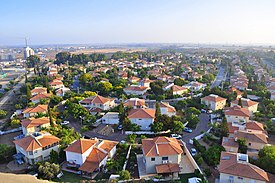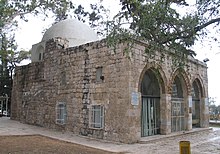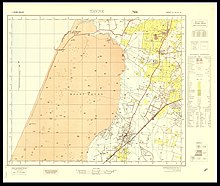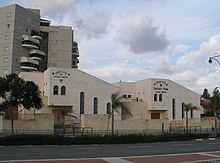Yavne
יַבְנֶה | |
|---|---|
| Hebrew transcription(s) | |
| • ISO 259 | Yabne |
 | |
| Coordinates: 31°53′N 34°44′E / 31.883°N 34.733°E | |
| Country | |
| District | Central |
| Founded | 2000 BCE (Canaanite city) 37 BCE (Herodian rule) 7th century Islamic period (Arab village) 1949 (Israeli city) |
| Government | |
| • Mayor | Roei Gabay |
| Area | |
| • Total | 10,700 dunams (10.7 km2 or 4.1 sq mi) |
| Population (2022)
[1] | |
| • Total | 56,232 |
| • Density | 5,300/km2 (14,000/sq mi) |
| Website |
www |
Yavne ( Hebrew: יַבְנֶה) or Yavneh is a city in the Central District of Israel. In 2022, it had a population of 56,232. [1]
Modern Yavne was established in 1949. It is located near the ruins of the ancient town of Yavne (known also as Jamnia and Jabneh), later the village of Yibna, and today the archeological site of Tel Yavne. Ancient Yavne holds a special place in Jewish history because of the ancient town's contribution to Judaism's recovery and reconstitution under sages ben Zakkai and Gamaliel II following the destruction of the Second Temple. This period, sometimes known as the "Yavne period", became a crucial mark in the development of Rabbinic Judaism. [2] [3] [4] The city has a history of producing wine throughout much of antiquity, as indicated by both archeological findings and ancient sources. [5]
Name
In many English translations of the Bible, Yavne was known as Jabneh /ˈdʒæbnə/. In Greek and Latin-speaking sources, it was known as Jamnia ( Ancient Greek: Ἰαμνία Iamníā; Latin: Iamnia). Under Late Roman and Byzantine rule, it had a mixed population of Christians, Jews, and Samaritans. Under the Crusaders, the city was known as Ibelin, and was where the House of Ibelin resided. During the Ottoman and British periods, it was known as Yibna ( Arabic: يبنى). The ancient site is now found at the Tel Yavne archeological site, which is southeast of the modern city.
History

Ancient Yavne
Antiquity
Yavne was one of the major ancient cities in the southern coastal plain, situated 20 km (12.43 mi) south of Jaffa, 15 km (9.32 mi) north of Ashdod, and 7 km (4.35 mi) east of the Mediterranean. [6]
From excavations of the ancient tell (mound created by accumulation of archaeological remains) known as Tel Yavne (Hebrew), which developed on a natural kurkar hill, the area seems to have been inhabited, possibly continuously, from either the Bronze or Iron Age until the British Mandate. During some periods, especially the Byzantine period, the settlement expanded to cover part of the plain and hills surrounding the tell. [6] [7] [8] Yavne is mentioned in the Bible and other ancient texts. [7] [8]
In Roman times, the city was known as Iamnia or Jamnia. It was bequeathed by King Herod upon his death to his sister Salome. Upon her death it passed to Emperor Augustus, who ran it as a private imperial estate, a status retained for at least a century. [9] After Salome's death, Iamnia came into the property of Livia, the future Roman empress, and then to her son Tiberius. [10][ better source needed] In the 40s, conflict arose when some Gentiles in Jamnia provoked local Jews by erecting an altar to the Emperor. This act prompted Emperor Caligula to try placing his statue within the Holy of Holies at the Temple of Jerusalem. [11]
During the First Jewish–Roman War, when the Roman army quelled the insurrection in Galilee, the army marched upon Iamnia and Azotus, taking both towns and stationing garrisons within them. [12] According to rabbinic tradition, Rabbi Yohanan ben Zakkai and his disciples were permitted to settle in Iamnia during the outbreak of the war, after Zakkai, realizing that Jerusalem was about to fall, departed the city and sought the permission of Vespasian, commander of the Roman forces, to settle in Yavne and teach his disciples. [13] [14] Upon the fall of Jerusalem, his school functioned as a Sanhedrin. [15] It is also rumored to have been the site of the Council of Jamnia that established the rabbinic Jewish biblical canon.
According to the Jerusalem Talmud (Berakhot 1:4), when the rabbis argued over some fine point of Jewish law, a Divine voice ( Hebrew: bat ḳol) was heard in Yavne, ruling in favor of the School of Hillel. To counter a perceived threat to rabbinical authority, the Talmud states that Shmuel ha-Katan of Yavne enacted the " twelfth benediction" in the daily prayer, i.e., the benediction against apostates and heretics ( Hebrew: minim). [16]
Crusader period
The Crusaders renamed the city Ibelin and built its castle there in 1141. An excavation led by Professor Dan Bahat in 2005 [17][ better source needed] revealed the main gate. [18] Its namesake noble family, the House of Ibelin, was important in the Kingdom of Jerusalem and later in the Kingdom of Cyprus. Salvage excavations at the west of the tell unearthed a stash of 53 Crusader coins of the 12th and 13th centuries. [19]
Muslim Yibna, Early Islamic to Mamluk period
The Islamic historian al-Baladhuri (died 892 CE) describes Yibna as one of ten towns in Jund Filastin conquered by the Rashidun army led by 'Amr ibn al-'As in the early 7th century. [20] Ibelin was first sacked by Saladin before his army was routed at the Battle of Montgisard in late 1177. In August 1187, it was retaken and burnt to the ground, and ceased for some time to form part of the Crusaders' kingdom. [21]
Mosque
Ibelin's parish church was converted into a mosque, to which a minaret was added during the Mamluk period in 1337. The minaret is still standing, although the mosque itself (the former Crusader church) was blown up by the IDF in 1950. [7] [22]
Tomb of Abu Huraira/Gamaliel
The Mausoleum of Abu Huraira , known in Arabic as Maqam Abu Hurayra, described as "one of the finest domed mausoleums in Palestine", dates back to the 12th century. It was said to be the tomb of Abu Hurairah, a companion ( sahaba) of the Islamic prophet Muhammad. [23] [24] Abu Hurairah however is buried in Medina, Saudi Arabia, but he[ clarification needed] was also venerated in various places in Palestine, namely in Ramle and Yavne. [25] After 1948 the shrine was adopted by Mizrahi Jews who believe the tomb is the burial place of Rabbi Gamaliel of Yavne. [23] [24] Jewish worshippers say that it was a Jewish burial site that was Islamized later, although there is no record of Jewish pilgrimage there before 1948. [26]
British Mandate

In mid-March 1948, a contingent of Iraqi soldiers moved into the village. In a Haganah reprisal on 30 March, two dozen villagers were killed. On April 21, the Iraqi village commander was arrested in Jaffa for drunkenly shooting two Arabs. [27]
During the 1948 Arab–Israeli War, residents of Zarnuqa sought refuge in Yibna, but left after the villagers accused them of being traitors. [28]
On 27 May, following the fall of Al-Qubayba and Zarnuqa, most of the population of Yibna fled to Isdud, but armed males were refused entry. On 5 June, when Israeli troops arrived, they found the village almost deserted apart from a few old people who were ordered to leave. [28]
In the 1930s, a plan was proposed to rebuild the ancient Talmudic academy founded by Yochanan Ben Zakkai. In 1941, an agreement was reached between the Jewish National Fund and the Mizrachi/Hapoel Mizrachi movements, allocating five hundred dunams in Yavne area for a yeshiva. In 1948, the building was used as a forward post by Yigal Alon, commander of the southern front, because of its commanding view of the coastal plain. [29]
Foundation of Modern Yavne


Yavne was established in October 1948 as a transit camp for Jews from Arab countries, Iran and Europe. The first neighbourhood was established in early 1949. In the early years, the inhabitants were shopkeepers, farmers and construction workers. In 1953, the population was 1,600. In the 1960s, several enterprises moved from Tel Aviv to Yavne, establishing leather, textile, and metallurgy industries. By 1970, the population had grown to 10,100. [30] Other Israeli villages were founded on Yibna land were Kfar HaNagid and Beit Gamliel in 1949, Ben Zakai in 1950, Kfar Aviv (originally: "Kfar HaYeor") in 1951, Tzofiyya in 1955. [31] According to Walid Khalidi, a railroad crosses the village. The old mosque and minaret, together with a shrine can still be seen, and some of the old houses are inhabited by Jewish and Arab families.[ citation needed][ clarification needed]
The 1980 edition of a guidebook published in Jerusalem describes Yavne as home to Israel's first atomic reactor, an image of which appeared on a 0.50 Shekel stamp. [32]
When Mayor Meir Sheetrit assumed office in 1974, the city became a low-density suburban satellite of Tel Aviv with new construction targeting middle-class families. Yavne achieved city status in 1986. By the mid-1990s, the population had risen to 25,600. [30]
Demography

According to the Israel Central Bureau of Statistics (CBS), in 2021 the ethnic makeup of the city was 99 percent Jewish and others, without significant Arab population. [33] As of March 2021 the city numbered 53,595 persons, with a high percentage of young people: 37% of the population was in the 0–19 age group and 71% of the total population was younger than 44. [33] [34]

Economy
Major companies based in Yavne include Ormat Industries, Aeronautics Defense Systems, Avisar and Orbotech. In 2019, Merck established an incubator in Yavne with a budget of about €20 million over three years that will invest in startups focusing on semiconductor and display crystal technologies. [35] In 2022 Recipharm established a new facility in Yavne. [36] MediWound manufactures NexoBrid in Yavne, a unique product for the treatment of severe burns. [37] It allows saving affected tissue which would otherwise need to be removed, leading to less amputations of hands and feet. [37] Many October 7, 2023 victims have benefitted from it, with the US also buying $20 million worth of NexoBrid for its strategic national stockpile. [37]
In 2012 a new green neighborhood "Neot Rabin" was inaugurated in the south of the city. [38]
Sports
Maccabi Yavne is the city's major football club. During the 1980s the club played in the top division and in 1985 won the Toto Cup. Today they are in Liga Leumit. The basketball team, Elitzur Yavne, have also played in the Liga Leumit (basketball) since 2007.
Omri Casspi, the first Israeli to play in the National Basketball Association, grew up in the city and played for some of its teams. [39]
Archaeology
Tel Yavne was first excavated in 2005 in a dig headed by Dan Bahat, who unearthed the gate room of the Crusader castle of Ibelin, as well as a vault destroyed with gunpowder by the Mamluks and deeply embedded Crusader walls east of it, all at or around the top of the tell. [40]
In December 2019, a large number of pottery kilns and 1,200-year-old gold coins which may have been a local potter's " piggy bank" were unearthed in a juglet by the Israeli Antiquities Authority. According to archaeologist Robert Kool, the coins date back to the early Abbasid period, about 9th century CE. One of the seven coins was minted by Caliph Harun al-Rashid (786–809 CE). "These are gold dinars issued by the Aghlabid dynasty that ruled in North Africa. Without a doubt this is a wonderful Hanukkah present for us," said Kool. [41] [42] In August 2020, Israeli archaeologists discovered 425 complete gold coins, most dating to the Abbasid period around 1,100 years ago. [43] In April 2021, archaeologists announced the discovery of a 1,600-year-old multicolored mosaic dated back to the Byzantine period in an industrial area. According to IAA archaeologist Elie Haddad, it was the first time that excavators revealed a colored mosaic floor in Yavne. [44] [45] [46]
The ancient harbour of Yavne, Yavne-Yam (in Arabic Minet Rubin) was identified on the coast. Excavations have revealed fortification going back to the Bronze Age Hyksos. [8] It was in use from the Middle Bronze Age until the 12th century CE, when it was abandoned. [47] 2 Maccabees 12:8–9 refers to the burning of the harbour and its fleet on the direction of Judas Maccabeus.
In 2022, a sling bullet was discovered with the Greek inscription "Victory of Heracles and Hauronas", the two gods were the patrons of the city during the Hellenistic period. [48]

Notable people
- Avior Byron (born 1973), singer, songwriter, and musicologist
- Omri Casspi (born 1988), Israeli professional NBA basketball player
- Itai Chammah (born 1985), Olympic swimmer
- Gil Dor, guitar player
- Elishay Kadir (born 1987), basketball player
- Uri Kokia (born 1981), basketball player and coach
- Shlomi Koriat (born 1976), actor and comedian
- Maor Melikson, footballer
- Nevo Mizrahi (born 1987), footballer
- Mushail Mushailov, artist
- Ido Nehoshtan, Major-General (ret.), former chief of Israeli Air Force
- Shabak Samech, rap and hip-hop group
- Meir Sheetrit (born 1948), Israeli Minister of the Interior
Sister cities
Yavne is twinned with:
-
 Le Raincy,
France
Le Raincy,
France -
 Speyer,
Germany
Speyer,
Germany -
 Sunrise, Florida,
United States
Sunrise, Florida,
United States -
 East Brunswick, New Jersey,
United States
East Brunswick, New Jersey,
United States
See also
References
- ^ a b "Regional Statistics". Israel Central Bureau of Statistics. Retrieved 21 March 2024.
-
^ Katz, Steven T., ed. (2006).
The Cambridge History of Judaism: Volume 4: The Late Roman-Rabbinic Period. Vol. 4. Cambridge: Cambridge University Press. p. 268.
doi:
10.1017/chol9780521772488.
ISBN
978-0-521-77248-8.
Under the leadership of R. Yohanan ben Zakkai and his circle at Yavneh, Judaism sought to reconstitute itself and find a new equilibrium in the face of the disaster of 70.
- ^ Neusner, Jacob (2016-09-26). "The Formation of Rabbinic Judaism: Yavneh (Jamnia) from A.D. 70 to 100". In Haase, Wolfgang (ed.). Religion (Judentum: Palästinisches Judentum [Forts.]) (in German). De Gruyter. doi: 10.1515/9783110839043-002. ISBN 978-3-11-083904-3.
-
^
Jews and Christians in the first and second centuries : the interbellum 70-132 CE. Joshua Schwartz, Peter J. Tomson. Leiden, The Netherlands. 2018.
ISBN
978-90-04-34986-5.
OCLC
988856967.
{{ cite book}}: CS1 maint: location missing publisher ( link) CS1 maint: others ( link) - ^ "Largest wine factory in the world from Byzantine period unearthed". The Jerusalem Post | Jpost.com. Retrieved 2023-01-05.
- ^ a b Moshe Fischer, Itamar Taxel and David Amit, Rural Settlement in the Vicinity of Yavneh in the Byzantine Period: A Religio-Archaeological Perspective, Bulletin of the American Schools of Oriental Research, No. 350 (May, 2008), pp. 7-35.
- ^ a b c Raz Kletter, Irit Ziffer, Wolfgang Zwickel. "Yavneh I: The Excavation of the 'Temple Hill' Repository Pit and the Cult Stands." Orbis Biblicus et Orientalis, Series Archaeologica (OBOSA), Book 30. Academic Press Fribourg, Switzerland ( ISBN 978-3-7278-1667-3) and Vandenhoeck & Ruprecht, Göttingen ( ISBN 978-3-525-54361-0). 2010. Pages 2-13 [1]
- ^ a b c Negev, Avraham; Gibson, Shimon (2001). "Jabneh; Jabneel; Jamnia (a)". Archaeological Encyclopedia of the Holy Land. New York and London: Continuum. p. 253. ISBN 0-8264-1316-1.
- ^ Kletter, Raz (2004). "Tel Yavne". Excavations and Surveys in Israel. 116. Retrieved 2017-12-31.
- ^ "Jabneh". Jewish Virtual Library.
- ^ Millar, Fergus (1995). The Roman Near East: 31 BC–AD 337. Cambridge, Massachusetts: Harvard University Press. p. 58. ISBN 978-0-674-77886-3.
- ^ Josephus, The Jewish War 4.3.2 (4.130)
- ^ Nathan ha-Bavli (1976). Shemuel Yerushalmi (ed.). Avot de-Rabbi Natan (in Hebrew). Jerusalem: Mekhon Masoret. p. 29 (chapter 4, section 5). OCLC 232936057.
- ^ Ben-Israel, Uriah (1979). "Yavne". In Alon, David (ed.). Israel Guide - Sharon, Southern Coastal Plain and Northern Negev (in Hebrew). Vol. 6. Jerusalem: Keter Publishing House. p. 132. OCLC 745203905.
- ^ Babylonian Talmud, Gittin 56b
- ^ Eisenstein, J.D., ed. (1935), "יבנה", Ozar Yisrael - An Encyclopedia of all matters concerning Jews and Judaism, in Hebrew (in Hebrew), vol. 5, London: Shapiro, p. 48, OCLC 917796525; cf. Babylonian Talmud, Berakhot 28b
- ^ Archaeological Excavations in Israel 2006, Israel Ministry of Foreign Affairs, accessed Sep 2021.
- ^ "Archaeologists uncover ruins of medieval wine factory at Israel's Yavne site". 12 October 2021.
- ^ Shimron, Ilanit (2009-04-06). מטמון נדיר נמצא בחפירות ארכיאולוגיות בתל יבנה [Rare Treasure Found in Excavations at Tel Yavne] (in Hebrew). Ynet. Archived from the original on 2011-10-05. Retrieved 2010-08-08.
- ^ al-Baladhuri, Book of the Conquest of the Lands, quoted in Le Strange (1890), p. 28
- ^ Fischer, Moshe and Taxel, Itamar. "Ancient Yavneh: Its History and Archaeology", in Tel Aviv Journal of the Institute of Archaeology of Tel Aviv University, December 2007, vol. 34: No 2, pp.204-284, 247
-
^ Denys Pringle (1998).
Yibna: Church (No. 280). Cambridge University Press. pp. 379–380.
ISBN
9780521390378. Retrieved 24 January 2016.
{{ cite book}}:|work=ignored ( help) - ^ a b Mayer et al., (1950:22) Cited in Petersen, Andrew (2002). A Gazetteer of Buildings in Muslim Palestine: Volume I (British Academy Monographs in Archaeology). Oxford University Press. p. 313. ISBN 978-0-19-727011-0.
- ^ a b Bar, Doron (2009). "Mizrahim and the development of sacred space in the State of Israel, 1948–1968". Journal of Modern Jewish Studies. 8 (3): 267–285. doi: 10.1080/14725880903262988. S2CID 145291702.
- ^ Baer, Eva (11 December 1989). Ayyubid Metalwork With Christian Images. BRILL. ISBN 9004089624 – via Google Books.
- ^ Gideon Bar (2008). "Reconstructing the past: The creation of Jewish sacred space in the State of Israel, 1948–1967". Israel Studies. 13 (3): 1–21. doi: 10.2979/ISR.2008.13.3.1. S2CID 144598350.
- ^ Morris, Benny (2004). The Birth of the Palestinian Refugee Problem Revisited. Cambridge: Cambridge University Press. p. 259. ISBN 9780521009676.
- ^ a b Morris, Benny (2004). The Birth of the Palestinian Refugee Problem Revisited. Cambridge: Cambridge University Press. pp. 258–259. ISBN 9780521009676.
- ^ Yeshivat Kerem B'Yavneh
- ^ a b Machline, Elise; Pearlmutter, David; Schwartz, Moshe; Pech, Pierre (25 April 2020). Green Neighbourhoods and Eco-gentrification: A Tale of Two Countries. Springer. ISBN 9783030380366.
- ^ Khalidi, 1992, p. 423
- ^ Vilnay, Zev (First edition 1955) Israel Guide. Daf-Chen Press Ltd, Jerusalem. Twenty-second edition - 1980. p.254
- ^ a b "Regional Statistics". cbs.gov.il. 2021. Retrieved 2023-05-07.
- ^ "Population Census 2008: Yavne" (PDF). cbs.gov.il. 2017-01-18. Retrieved 2023-05-07.
- ^ Solomon, Shoshanna. "German drugmaker Merck sets up Israel incubator to tap into chip, sensor tech". www.timesofisrael.com.
- ^ "מפעל רסיפארם ישראל נחנך ביבנה".
- ^ a b c "Innovative treatment helps family severely burned when Hamas set their home on fire". Renee Ghert-Zand for The Times of Israel, 19 Jan 2024 (posted & retrieved).
- ^ "פינוי אשפה פנאומאטי - צעד ירוק למען הסביבה ביבנה והסביבה - פורטל יבנה שלי". www.myavne.co.il.
- ^ Casspi is ready for primetime
- ^ Fischer and Taxel (2007), p.254
- ^ "Archaeologists find hoard of Islamic coins in Israel: 'It's like a Hanukkah present'". Haaretz. Retrieved 2020-08-08.
- ^ "Trove of 1,200-year-old 'Arabian Nights' gold coins uncovered in Israel". The Jerusalem Post | Jpost.com. Retrieved 2020-08-08.
- ^ "Youth volunteers uncover hundreds of ancient gold coins in Israel". CBC News. Retrieved 2020-08-08.
- ^ Jack Guy. "Archaeologists uncover 1,600-year-old mosaic in Israel". CNN. Retrieved 2021-05-04.
- ^ "1,600-year-old multicolored mosaic with geometric motifs uncovered in Yavne". Times of Israel. Retrieved 2021-05-04.
- ^ Gershon, Livia. "Colorful, 1,600-Year-Old Mosaic Adorned With Geometric Patterns Found in Israel". Smithsonian Magazine. Retrieved 2021-05-04.
- ^ "Archeology in Israel - Yavne Yam".
- ^ 2,200-year-old Greek sling bullet discovered in Israel
External links
- Municipal website
 Singer, Isidore; et al., eds. (1901–1906).
"Jabneh".
The Jewish Encyclopedia. New York: Funk & Wagnalls.
Singer, Isidore; et al., eds. (1901–1906).
"Jabneh".
The Jewish Encyclopedia. New York: Funk & Wagnalls.- Yavneh Yields Over a Hundred Philistine Cult Stands Archived 2012-05-31 at the Wayback Machine Biblical Archaeology Review
- . Encyclopædia Britannica (11th ed.). 1911.
- 2008 salvage excavation report, Orit Segal at Excavations and Surveys in Israel, 5 July 2011. Accessed 22 Feb 2017.



